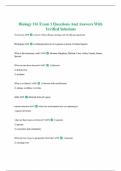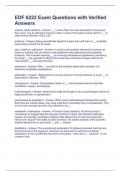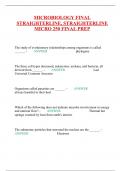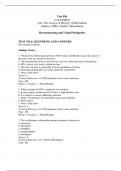What is phylogeny - Study guides, Class notes & Summaries
Looking for the best study guides, study notes and summaries about What is phylogeny? On this page you'll find 541 study documents about What is phylogeny.
Page 2 out of 541 results
Sort by

-
microbiology straighterline final Exam Correctly Solved!!
- Exam (elaborations) • 10 pages • 2023
-
Available in package deal
-
- $10.99
- 1x sold
- + learn more
phylogeny - ANSWERThe study of evolutionary relationships among organisms is called ______. Last Universal Common Ancestor - ANSWERThe three cell types discussed, eukaryotes, archaea, and bacteria, all derived from ______. always harmful to their host - ANSWEROrganisms called parasites are ______. Thermal hot springs warmed by heat from earth's interior - ANSWERWhich of the following does not indicate microbe involvement in energy and nutrient flow? Electrons - ANSWERThe subatomic p...

-
Biology 116 Exam 1 Questions And Answers With Verified Solutions
- Exam (elaborations) • 38 pages • 2024
-
Available in package deal
-
- $17.49
- + learn more
Biology 116 Exam 1 Questions And Answers With Verified Solutions Taxonomy ANS science of describing, naming, and classifying organisms Phylogeny ANS evolutionary history of a species or group of related species What is the taxonomy scale? ANS Domain, Kingdom, Phylum, Class, Order, Family, Genus, Species What are the three domains? ANS 1) Bacteria 2) Eukaryotes 3) Archaea What is evolution? ANS 1) descent with modification 2) change in alleles over time allele ANS alterna...

-
EDF 6222 Exam Questions with Verified Answers
- Exam (elaborations) • 9 pages • 2023
- Available in package deal
-
- $10.49
- 2x sold
- + learn more
science, lawful relations - Answer- __ is more than the mere description of events as they occur. It is an attempt to discover order, to show that certain events stand in __ to other events (Skinner, 1953, p.6)." evidence - Answer- Being scientifically skeptical means that until there is __ available, assumptions should not be made. bias, evidence, replication - Answer- In order to be excellent stewards of science, as behavior analysts, we can follow a few guidelines when gathering and ev...

-
Microbiology Straighterline Final Exam 2023 Questions and Answers.
- Exam (elaborations) • 14 pages • 2023
-
- $10.99
- 1x sold
- + learn more
Microbiology Straighterline Final Exam 2023 Questions and Answers. phylogeny - ANSWER The study of evolutionary relationships among organisms is called ______. Last Universal Common Ancestor - ANSWER The three cell types discussed, eukaryotes, archaea, and bacteria, all derived from ______. always harmful to their host - ANSWER Organisms called parasites are ______. Thermal hot springs warmed by heat from earth's interior - ANSWER Which of the following does not indicate microbe involveme...

-
MICROBIOLOGY FINAL STRAIGHTERLINE, STRAIGHTERLINE MICRO 250 FINAL PREP
- Exam (elaborations) • 96 pages • 2024
- Available in package deal
-
- $11.49
- + learn more
MICROBIOLOGY FINAL STRAIGHTERLINE, STRAIGHTERLINE MICRO 250 FINAL PREP The study of evolutionary relationships among organisms is called ______. - ANSWER phylogeny The three cell types discussed, eukaryotes, archaea, and bacteria, all derived from ______. - ANSWER Last Universal Common Ancestor Organisms called parasites are ______. - ANSWER always harmf...

-
CPDT-KA Study Guide | 100% Correct Answers | Latest Version 2024 | Expert Verified | Ace the Test
- Exam (elaborations) • 17 pages • 2024
- Available in package deal
-
- $12.49
- + learn more
Species Designation Canis Lupis Familiaris What does "Tame" mean? (v) to domesticate; (adj) a domesticated animal which is not dangerous or frightened of people; What is "Domestication"? (v) Adapting an animal (or plant) to life in intimate association with and to the advantage of humans; (adj- "domestic") An animal that has undergone extensive behavioral and biological changes resulting from selective breeding over the course of many generations resulting in tameness What does "Ne...

-
OPENSTAX MICROBIOLOGY TEST BANK (COVERS CHAPTER 1-26 OF THE BOOK) Complete Guide. Latest Update 2024
- Exam (elaborations) • 553 pages • 2024
-
- $17.48
- 1x sold
- + learn more
Opens tax Microbiology Test Bank Chapter 1 : An Invisible World Chapter 2 : How We See the Invisible World Chapter 3 : The Cell Chapter 4 : Prokaryotic Diversity Chapter 5 : The Eukaryotes of Microbiology Chapter 6 : Acellular Pathogens Chapter 7 : Microbial Biochemistry Chapter 8 : Microbial Metabolism Chapter 9 : Microbial Growth Chapter 10 : Biochemistry of the Genome Chapter 11 : Mechanisms of Microbial Genetics Chapter 12 : Modern Applications of Microbial Genetics Chapter 13 :...

-
CPDT-KA Study Guide Latest Update 100% Pass
- Exam (elaborations) • 17 pages • 2024
-
- $10.49
- + learn more
Species Designation Canis Lupis Familiaris What does "Tame" mean? (v) to domesticate; (adj) a domesticated animal which is not dangerous or frightened of people; What is "Domestication"? (v) Adapting an animal (or plant) to life in intimate association with and to the advantage of humans; (adj- "domestic") An animal that has undergone extensive behavioral and biological changes resulting from selective breeding over the course of many generations resulting in tameness What does "Ne...

-
Life: The Science of Biology, Ninth Edition Sadava • Hillis • Heller • Berenbaum CH 22 Reconstructing and Using Phylogenies
- Exam (elaborations) • 39 pages • 2023
-
- $11.99
- + learn more
1. Which of the following properties of HIV makes it difficult to trace the source of the virus from one person to the next? a. The transmission of the virus involves very few (often just one) viral particles. b. HIV evolves very slowly within the host. c. The host can have a genetically diverse population of viruses. d. Molecular phylogenies of viruses cannot be constructed. e. None of the above Answer: c Textbook Reference: 22.0 Phylogenetic trees in the courtroom Page: 464 Bloom’s ...

-
FNR 24150 Herps Final Exam Questions With Complete Solutions
- Exam (elaborations) • 40 pages • 2024
-
- $15.99
- + learn more
Why did amphibians move to land? - Unexploited food and niches - aquatic niches occupied - Lack of large terrestrial predators - Low O2 in warm water - unlimited O2 on land What are the three main diversifications of reptile and amphibian phylogeny? When did they begin to diversify? Ichthyostega - Paleozoic Devonian Leptospondyli - Paleozoic Carboniferous Temnospondyli - Paleozoic Carboniferous What was the name of the radiation that created the groups of amphibians we see today? When wa...

$6.50 for your textbook summary multiplied by 100 fellow students... Do the math: that's a lot of money! Don't be a thief of your own wallet and start uploading yours now. Discover all about earning on Stuvia


